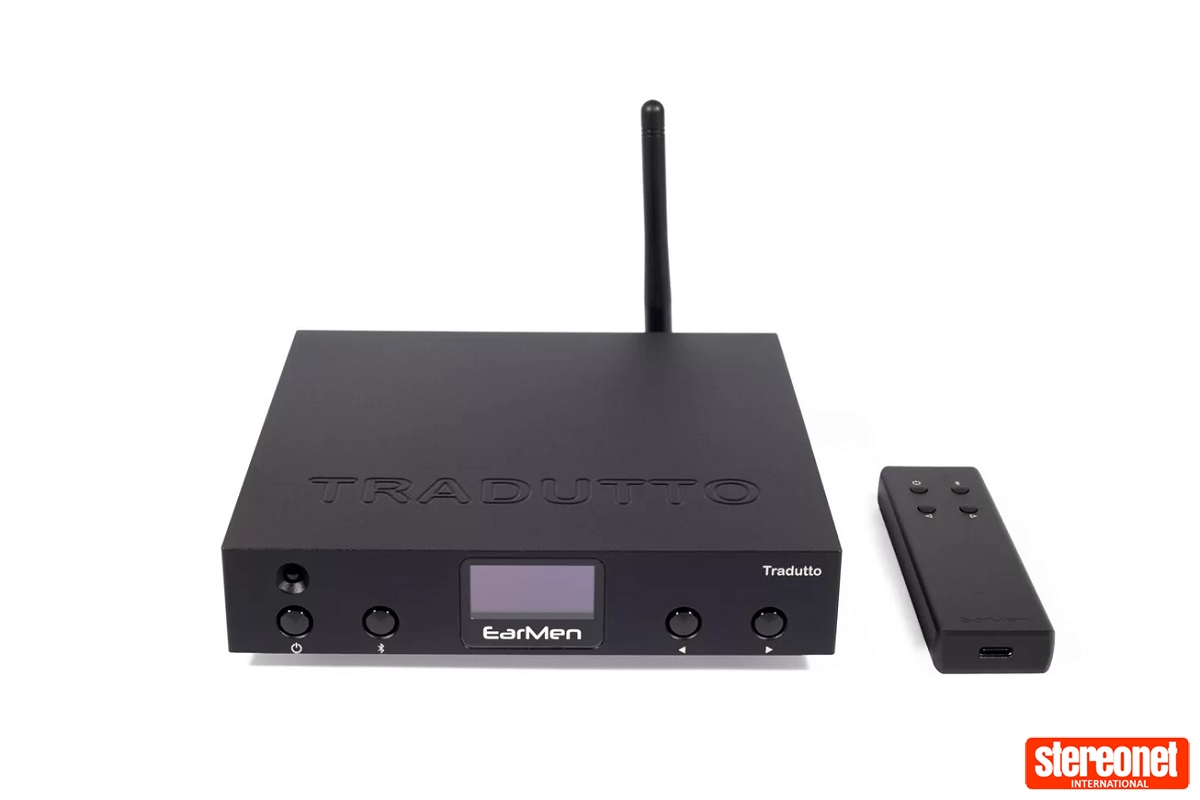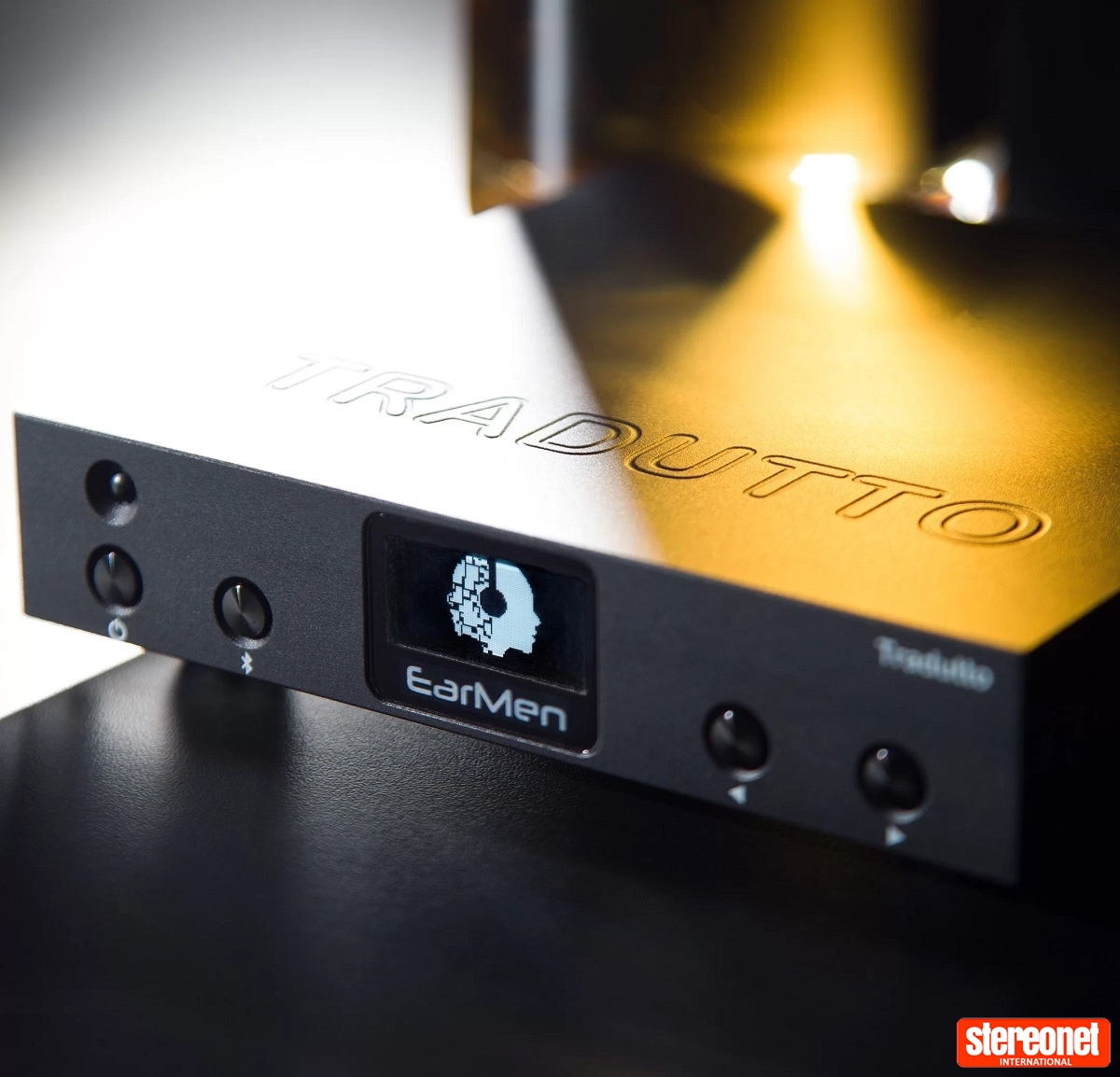EarMen Tradutto DAC Review

Jay Garrett samples this impressive sounding compact, affordable DAC…
EarMen
Tradutto DAC
£799

Although the news tells us that analogue sources are still rising in popularity, streaming is still the best way to access millions of tracks without needing shelves and units to store them. Furthermore, once their favourite streamed tracks have been heard through good wired headphones or a decent stereo speaker system, many modern music fans will not understand the need to hand over space in their homes to store LPs or CDs.
After the quality of the streamed music itself, pivotal to what you hear from your streaming service is the DAC used to convert the digital signal to analogue before it reaches your amplifier, then goes out through your earphones or speakers. As with everything in hi-fi, there's a fair range to choose from at varying price points, including iFi's £99 ZEN Air DAC and Topping's E50 at £270, going up to the likes of the £6,000 Auralic Vega G2.1, the £10,000 dCS Bartók and beyond.
For many, king of the compact desktop DAC is StereoNET's Applause Award-winning Chord Qutest. Now priced at £1,350, it might sit on the wrong side of a grand for some. So, does the £799 Tradutto from EarMen have the chops to satisfy those taking digital audio more seriously?

Looking at its spec sheet, the Tradutto certainly makes a strong case for itself. Offering USB Type-B, TOSLINK optical and coaxial RCA digital, alongside Bluetooth 5.1 aptX HD/ aptX Adaptive (via Qualcomm's QCC5124 flagship chip), these input options should serve most. Conversion is handled by an ESS ES9038K2M DAC chip sat on the gold-plated PCB, which is good for processing up to 32/768 PCM, DXD up to 768kHz, and DSD512. The Tradutto also decodes MQA thanks to an XMOS 16-core XU216 chip, and even is spotted by your Roon network should you have one. You also get a pair of RCA analogue outputs plus a balanced 4.4mm jack port.

The manufacturer says that it has minimised the current drawn by the Tradutto, as well as improved the power filtering, and reduced interference from Bluetooth, WiFi or mobile phone signals. Additionally, the analogue and digital sections are isolated, and the manufacturer has used MELF low noise resistors and Soundplus OPA1642 op-amps, resulting in a claimed THD of 0.0003% through the balanced output. Aside from lowering distortion, EarMen says it has paid careful attention to the clock circuitry to minimise jitter.
All this tech is wrapped up in a fuss-free but well-made case, hewn from an aluminium billet and finished in matte black. Measuring 30x150x150mm (HxWxD), the Tradutto is equally welcome as part of a desktop system as it is upon a hi-fi rack. Additionally, if you are planning to sit it in your main system, then the nifty little USB-rechargeable aluminium remote could prove handy. This takes care of scrolling through the input options as well as selecting Bluetooth and power on/off functions. These buttons are replicated on the Tradutto's fascia.

The screen shows the input currently being used except for USB, where the file type and sampling rate are shown. Selecting your required input is achieved via the left and right buttons with the sequence USB, TOSLINK, Coaxial, and Bluetooth. Oddly, this does not cycle through back to USB afterwards. Instead, you have to click back in reverse. A minor yet slightly confusing niggle.
While the overall fit and finish is generally impressive, the base plate has cooling vents that I assume have been punched into it – making for rather coarse edges. Although this is not an area most users will ever come in contact with, I feel a product at this price should be suitably finished. Still, it looks stylishly purposeful and generally a high-quality bit of kit.
THE LISTENING
The Tradutto will surely find fans amongst desktop audio enthusiasts, thanks to its ability to retrieve detail while remaining musical, and not relying on an overly lit upper midband to get that across. Instead, it's a balanced, grown-up sounding device that should have wide appeal.

The Tradutto took the place of my Chord Qutest DAC, using the USB digital audio feed from my PC at one side, while the RCA phono line outputs were plugged into the Euterpe valve head amp from EarMen's stablemate, Auris Audio. The sound through the Ultrasone Edition 15 Veritas headphones was really impressive. Even through the Euterpe's valve stage, I could sense that the Tradutto has a slightly less analytical approach to number-crunching than the Qutest. However, I did not feel that I was losing out on any of the minor details I relied on the Chord unit to excavate and present to me.
Feeding the Tradutto with a hi-res file of Nine Inch Nails' cover of Dead Souls made good on the promise of a quiet background. It also demonstrated the unit's skill in dynamics and grip as it presented a visceral performance even though I could detect a slight opaqueness, especially in the midband. And while this removed some of the tonal starkness from the track, I could not say that it diminished my enjoyment at any point.

Meanwhile, Yes, Anastasia by Tori Amos proved that vocals were served to the listener with care. The Tradutto does seem to have a more forward presentation than the Qutest and therefore brings the listener a few rows forward in the auditorium. And while that means detail aplenty, it also means that soundstaging seems a little more focused and intimate rather than expansive. Nevertheless, there was still depth enough to allow the piano room to breathe, and the orchestration of this fantastic piece of music never felt constrained. Still, the sound didn't quite push as far beyond my earphones with the EarMen as it did with the Chord component, and I did feel that the overall dynamic range had been compressed or somewhat evened out, resulting in less emotive contrast.
Sitting the Tradutto in a system comprising a Naim NAIT XS 3 and a pair of Focal Aria 906 seemed to even out the DAC's slightly warm temperament without totally crushing its sonic friendliness – nor its ability to impress. Indeed, it only took a few moments of Sohn's Veto playing before I was enjoying clear and well-separated instrumentation. Bass extension, while not exaggerated (even through a set of Audiovector R3 floorstanders I also brought into play), was fulsome. Although there was plenty of low-end punch, effects such as the finger snaps still cut through sharply. Meanwhile, the harmonised vocals were placed in the scene with space enough to separate them from the backing music.

Chris Jones' No Sanctuary Here is a good test of whether a system has low-frequency shortcomings, especially around the mid-bass. Here you have male lead vocals alongside bass guitar with what sounds like a sub-bass harmoniser effect rumbling away, while acoustic guitar harmonics shimmer through the mix. If you have anything in your chain incapable of untangling all of that, you will end up with a low-end mush rather than the enjoyable rich sound I was treated to. The Tradutto served this track well, giving it a wonderfully round heft as well as providing each note with plenty of definition and clean edges.
Crisp guitar and laser-cut leading edges were all present and correct through Tom Petty's Mary Jane's Last Dance, too. Even with the sometimes bitey Focals, the Tradutto relayed the top-end without pushing it beyond the realms of true-to-life extension. Instead, the angular guitars were defined and three-dimensional. Even when the harmonica came into play, everything sat right.

One thing that the Tradutto can do that the Qutest can't, is serve audio squirted over via Bluetooth, and with aptX Adaptive onboard, I was expecting good things. While Billie Eilish's Bad Guy throbbed through my listening space – sent from my Pixel 6 Pro playing Qobuz – I concluded that this is an ad hoc option rather than a reason for purchasing the Tradutto. If I was looking to add Bluetooth connectivity to my systems, I would probably opt for the iFi ZEN Blu as it seemed a tad clearer and more detailed than through the Tradutto. Still, a nice option to have in what is otherwise an exceptionally competent bit of kit.
THE VERDICT
 The EarMen Tradutto is a skilled and compact DAC worthy of space on any hi-fi enthusiast's desktop. While its Bluetooth functionality might be more of a bonus than the star attraction, its performance is excellent at the price. Indeed, its slightly warm presentation makes it a good match for long days in front of a screen. Furthermore, it can sit amongst more expensive hi-fi separates without embarrassing itself. It looks good, sounds cool and offers fine value compared to its rivals. And finally, its Roon-friendliness wins it extra credits from me. So, if you're looking at DACs in this price range, do include this.
The EarMen Tradutto is a skilled and compact DAC worthy of space on any hi-fi enthusiast's desktop. While its Bluetooth functionality might be more of a bonus than the star attraction, its performance is excellent at the price. Indeed, its slightly warm presentation makes it a good match for long days in front of a screen. Furthermore, it can sit amongst more expensive hi-fi separates without embarrassing itself. It looks good, sounds cool and offers fine value compared to its rivals. And finally, its Roon-friendliness wins it extra credits from me. So, if you're looking at DACs in this price range, do include this.
Visit EarMen for more information
Jay Garrett
StereoNET’s resident rock star, bass player, and gadget junkie. Jay heads up StereoNET as Editor for the United Kingdom and Europe regions. His passion for gadgets and Hi-Fi is second only to being a touring musician.
Posted in: Applause Awards | 2022 | DACs | Hi-Fi
JOIN IN THE DISCUSSION
Want to share your opinion or get advice from other enthusiasts? Then head into the Message
Forums where thousands of other enthusiasts are communicating on a daily basis.
CLICK HERE FOR FREE MEMBERSHIP
Trending
Cars as Speakers? Ford’s Patent Aims to Redefine Outdoor Sound
Napster’s Next Remix Signals Immersive Future for Streaming Pioneer
Audio-Technica’s Hotaru Levitates Analog Listening to New Heights
Arlo and Samsung SmartThings Strengthen Partnership with AI-Driven…
Vertere DG-X Turntable Spins Simplicity into High-End Sound
applause awards
Each time StereoNET reviews a product, it is considered for an Applause Award. Winning one marks it out as a design of great quality and distinction – a special product in its class, on the grounds of either performance, value for money, or usually both.
Applause Awards are personally issued by StereoNET’s global Editor-in-Chief, David Price – who has over three decades of experience reviewing hi-fi products at the highest level – after consulting with our senior editorial team. They are not automatically given with all reviews, nor can manufacturers purchase them.
The StereoNET editorial team includes some of the world’s most experienced and respected hi-fi journalists with a vast wealth of knowledge. Some have edited popular English language hi-fi magazines, and others have been senior contributors to famous audio journals stretching back to the late 1970s. And we also employ professional IT and home theatre specialists who work at the cutting edge of today’s technology.
We believe that no other online hi-fi and home cinema resource offers such expert knowledge, so when StereoNET gives an Applause Award, it is a trustworthy hallmark of quality. Receiving such an award is the prerequisite to becoming eligible for our annual Product of the Year awards, awarded only to the finest designs in their respective categories. Buyers of hi-fi, home cinema, and headphones can be sure that a StereoNET Applause Award winner is worthy of your most serious attention.





